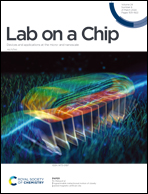Bio-inspired progressive motile sperm separation using joint rheotaxis and boundary-following behavior†
Abstract
Infertility, as a daunting ever-increasing challenge, poses a worldwide issue to both couples and the healthcare sector. According to the World Health Organization, half of infertility cases are attributed to male factor infertility, either partly or completely. Semen parameters of concern including sperm count, morphology, and motility are deemed to play a vital role in the insemination process. Density gradient centrifugation, being a clinically established procedure for improving on the mentioned parameters, has long been proven to inflict damage on the DNA content of the sperm cells, inducing DNA fragmentation. Herein, a bio-inspired microfluidic device is proposed that capitalizes on the geometry of the uterotubal junction (UTJ) of the female reproductive tract, which can act as a rheological barrier. The device leverages sperm rheotaxis and boundary-following behavior which have been considered as major migratory mechanisms used by sperm during the fertilization process in the female body. The device consists of a series of parallel channels that guide progressive motile sperms into the main sorting channel, where the hydrodynamic barriers created by two consecutive UTJ-like constrictions select sperms based on their propulsive velocity and linearity of motion. The sequential sorting employed here allows for the fractionation of the sperm population into two subpopulations with varying degrees of motility. Both sorted populations showed a significant increase in straight line velocity, reaching 63.4 ± 14.4 μm s−1 and 74 ± 13.8 μm s−1 in the first and second pools, respectively from 35.2 ± 27.2 μm s−1 in raw semen. Additionally, sorted populations demonstrated over 30% reduction in DNA fragmentation index, an indication that the proposed device selects for undamaged sperms with high quality. Apart from the biological superiority of the sorted sperms, this device presents itself as an easy and clinically-applicable method for the separation of progressive motile sperms, while at the same time, benefiting from a straightforward procedure for sperm retrieval.



 Please wait while we load your content...
Please wait while we load your content...